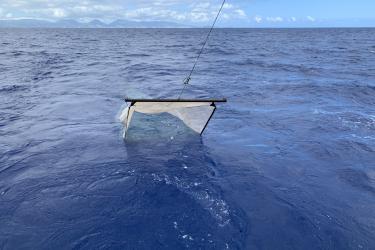NOAA’s Pacific Islands Fisheries Science Center conducted the 2021 Hawaiʻi Small Boat Survey to better understand the important economic, social, and cultural contributions that small boat fishing provides to the State of Hawaiʻi. All commercial marine license (CML) holders who had landed at least one fish in 2020 were eligible to participate in the survey. Fishers had the opportunity to complete the survey online or through a booklet in the mail. Thank you for your support—we received 350 responses out of 879 (40 percent) surveys sent!


Left: For the 2021 Hawaiʻi small boat survey, the distribution of CML holders (survey population) among islands includes 97 for Kauaʻi, 296 for Oʻahu, 5 for Molokaʻi, 4 for Lanaʻi, 122 for Maui, 352 for Hawaiʻi county, and 3 for U.S. mainland. Right: We received 350 returns, including 228 completed by mail and 122 completed online. The number of returns include 123 for Oʻahu, 132 for Hawaiʻi county, 51 for Maui county, and 42 for Kauaʻi county. The response rates by county include 42 percent for Oahu, 38 percent for Hawaiʻi county, 39 percent for Maui, and 43 percent for Kauaʻi.
CHARACTERISTICS OF BOAT FISHING TRIPS IN 2020


Left: The distribution of the number of boat fishing trips in 2020 includes 22% of respondents with less than 12 trips, 33 percent with 12–24 trips, 24 percent with 25–49 trips, 14 percent with 50–99 trips, and 7 percent with 100 trips or more. Right: The distribution of the number of fishing gears being used in 2020 boat fishing trips includes 8 percent of respondents used one gear, 23 percent used two gears, 31 percent used three gears, 26% used four gears, and 12 percent used five gears or more.


Left: The average vessel characteristics in 2020 includes 24 feet for fishing vessel, purchase price of $53,148, and market value of $62,222. The median (the middle value that separates the higher half from the lower half of a list of numbers) of vessel characteristics in 2020 includes 22 feet for fishing vessel, purchase price of $35,000, and market value of $40,000. Right: The most commonly used gear in 2020 boat fishing trips includes 95 percent of respondents used trolling, 71 percent used dead bait/live bait for pelagic species, 59 percent used handline/rod and reel for shallow bottomfish, 58 percent used landline for deep 7 bottomfish, 14 percent used spearfishing, and 14 percent use other gear.



The primary motivations for fishing in 2020 include 34 percent recreational expense, 30 percent part-time commercial, 16 percent subsistence, 11 percent full-time commercial, 8% purely recreational, and 1 percent cultural. The primary motivations for fishing in 2013 include 27 percent recreational expense, 51 percent part-time commercial, 3 percent subsistence, 7 percent full-time commercial, 11 percent purely recreational, and 1 percent cultural. Compared to 2013 fisher self-classifications, we saw a large increase in subsistence as the “primary” motivation for fishing in 2020, perhaps in response to the COVID-19 pandemic. Credit: NOAA Fisheries.


Left: 342 respondents reported their landings (include pelagic fish, deep 7 bottomfish, shallow bottomfish, and nearshore and reef fish) in 2020. Total landings reported by the 342 respondents are 1.08 million lb. The average landings per fisher is 3,162 lb and the median landings is 925 lb. The distribution of total pounds of fish caught in 2020 by fishing motivation includes 47 percent from full-time commercial, 24 percent from part-time commercial, 13 percent from recreational expense, 6 percent from subsistence, 4 percent from cultural, one percent from purely recreational, and 5 percent from fishermen with other motivation. NOAA Fisheries. Right: 280 respondents reported their value of fish sold in 2020. Total value reported by the 280 respondents are $2.83 million. The average revenue per fisher is $10,116 and the median revenue is $3,500. The distribution of value of fish sold in 2020 by fishing motivation includes 43 percent from full-time commercial, 27 percent from part-time commercial, 13 percent from recreational expense, 6 percent from subsistence, 3 percent from cultural, one percent from purely recreational, and 7 percent from fishermen with other motivation. Photo: NOAA Fisheries.


Left: The average landings by species group and primary motivation in 2020 include the following: Purely recreational: 378 lb pelagic, 84 lb deep 7 bottomfish, 47 lb shallow bottomfish, 107 lb nearshore and reef fish. Total landings are 615 lb. Recreational expense: 940 lb pelagic, 169 lb deep 7 bottomfish, 141 lb shallow bottomfish, 85 lb nearshore and reef fish. Total landings are 1,335 lb. Subsistence: 947 lb pelagic, 117 lb deep 7 bottomfish, 81 lb shallow bottomfish, 208 lb nearshore and reef fish. Total landings are 1,352 lb. Part-time commercial: 2,187 lb pelagic, 175 lb deep 7 bottomfish, 138 lb shallow bottomfish, 309 lb nearshore and reef fish. Total landings are 2,809 lb. Cultural: 7,881 lb pelagic, 263 lb deep 7 bottomfish, 213 lb shallow bottomfish, 1,331 lb nearshore and reef fish. Total landings are 9,688 lb. Full-time commercial: 12,149 lb pelagic, 1,087 lb deep 7 bottomfish, 482 lb shallow bottomfish, 1,267 lb nearshore and reef fish. Total landings are 14,986 lb. Right: The average value of fish sold by primary motivation in 2020 include the following: Purely recreational: $2,939, Recreational expense: $3,917, Subsistence: $6,382, Part-time commercial: $8,983, Cultural: $19,250, Full-time commercial: $35,709. Credit: NOAA Fisheries.


Left: 342 respondents reported their landings (include pelagic fish, deep 7 bottomfish, shallow bottomfish, and nearshore and reef fish) in 2020. Total landings reported by the 342 respondents are 1.08 million lb. The average landings per fisher is 3,162 lb and the median landings is 925 lb. The distribution of total pounds of fish caught in 2020 by fishing motivation includes 47 percent from full-time commercial, 24 percent from part-time commercial, 13 percent from recreational expense, 6 percent from subsistence, 4 percent from cultural, 1 percent from purely recreational, and 5% from fishermen with other motivation. Right: 280 respondents reported their value of fish sold in 2020. Total value reported by the 280 respondents are $2.83 million. The average revenue per fisher is $10,116 and the median revenue is $3,500. The distribution of value of fish sold in 2020 by fishing motivation includes 43 percent from full-time commercial, 27 percent from part-time commercial, 13 percent from recreational expense, 6 percent from subsistence, 3 percent from cultural, 1 percent from purely recreational, and 7 percent from fishermen with other motivation.


Left: Trip costs include boat fuel, truck fuel, oil, ice, bait, food and beverages, daily maintenance and repair, gear lost, and other expenses. The average trip cost for all trips is $302. The median trip cost is $250. Average trip costs and the percent of trip costs from fuel are summarized by gear type: Trolling: average trip costs is $304, 46 percent of trip costs is fuel cost. Dead bait/live bait for pelagic species: average trip costs is $300, 37 percent of trip costs is fuel cost. Handline for deep 7 bottomfish: average trip costs is $304, 36 percent of trip costs is fuel cost. Handline/rod and reel for shallow bottomfish: average trip costs is $258, 30 percent of trip costs is fuel cost. Spearfishing: average trip costs is $222, 32 percent of trip costs is fuel cost. Photo: NOAA Fisheries. Right: Average annual fishing expenditures increased 27 percent from 2013 ($5,557) to 2020 ($7,069). Almost all expenditure categories were higher in 2020 (except for loan payments). The annual fishing expenditure by category in 2020 and 2013 include the following: Boat and trailer repair, maintenance and improvements: $2,337 in 2020 and $1,635 in 2013. Gear replacement/repair from wear and tear: $1,969 in 2020 and $1,671 in 2013. Loan payment: $718 in 2020 and $970 in 2013. Boat insurance: $699 in 2020 and $420 in 2013. Fee (permit, registration, etc.): $648 in 2020 and $399 in 2013. Mooring fees: $629 in 2020 and $414 in 2013. Financial services: $49 in 2020 and $30 in 2013. Other expenses: $18 in 202 and $19 in 2013.




